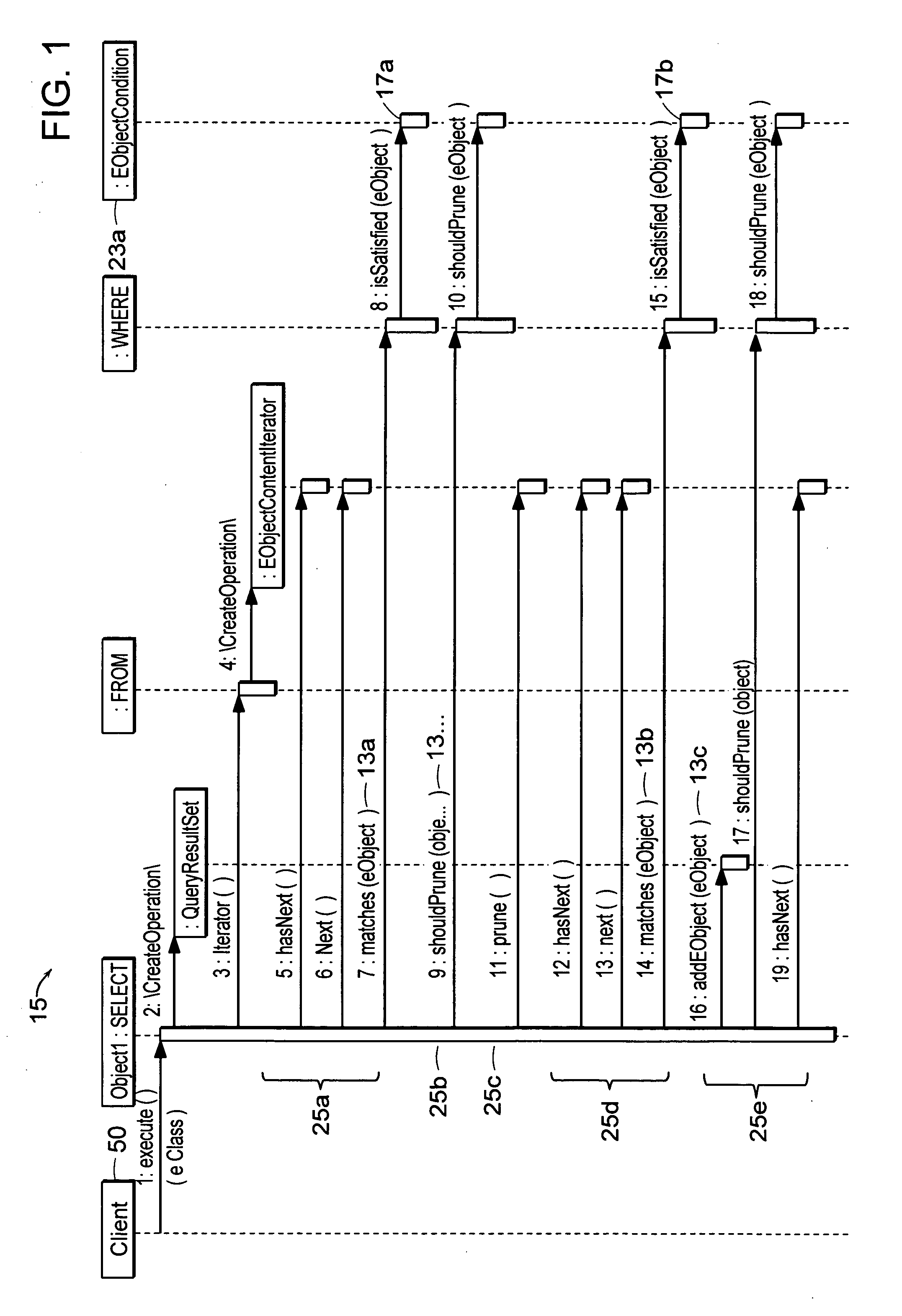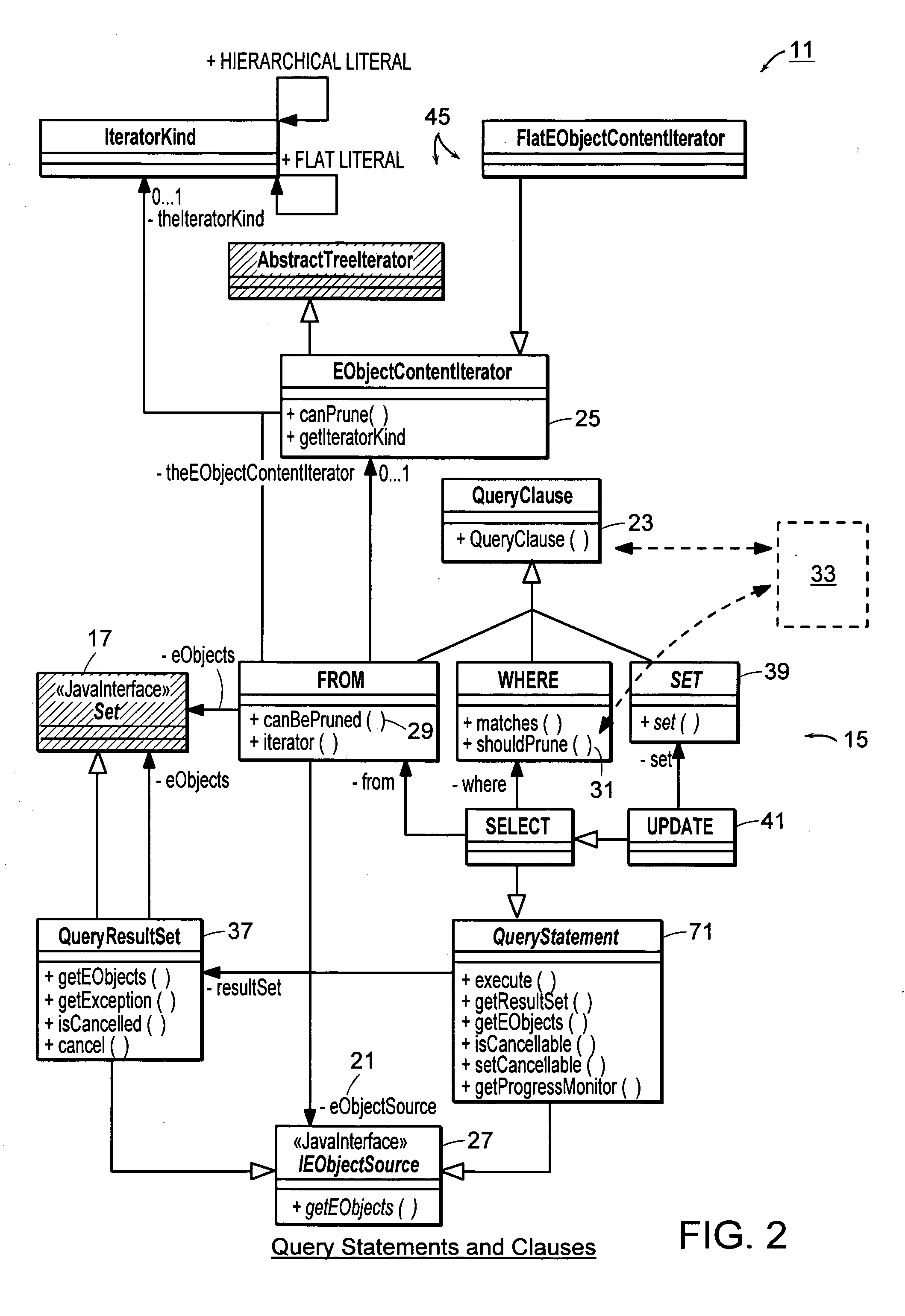Method and apparatus for querying program design models
a program design and program design technology, applied in the field of method and apparatus for querying program design models, can solve the problems of not being able to achieve the effect of facilitating the search process, unable to achieve standardized, generic or extensible ways to query eclipse emf metamodels for information, and not being able to portability search functions,
- Summary
- Abstract
- Description
- Claims
- Application Information
AI Technical Summary
Benefits of technology
Problems solved by technology
Method used
Image
Examples
example 1
Using Logical Connectives with Conditions
[0067] The logical connectives supported by the Condition object 49 in the invention framework 11 are the following:
[0068] AND, OR, XOR, NOT, IMPLIES and EQUIVALENT.
[0069] Using a C++ operator overloading technique, the logical connectives are implemented as member functions of the Condition object 49 itself (except for the NOT, which is implemented as a Condition subclass). If one is to speak of associativity of these pseudo-operators, it is from left-to-right, and all are of equal precedence. These pseudo-operators are “stackable”, meaning that the return result of any of these operator-functions is a new Condition object 49 that itself, in turn, may be combined with another Condition 49 using yet another logical-operator-function. This makes it easier for clients to construct complex conditions 49 on one line.
[0070] The behavior of these pseudo-operators is the same as their Java built-in counterpart except for IMPLIES and EQUIVALENT w...
example 2
Query for all Classes with a Given Name
[0077] The following example constructs and executes a query that asks for all classes in a given model that are named: “MyLostClass”. An equivalent SQL query would be like:
[0078] SELECT*FROM classes WHERE name=‘MyLostClass’
[0079] Using the present invention EMF Query method and apparatus 11, the code would look like the following:
/ / get the model to queryEObject model = getModel( ); / / build the Select statementQueryStatement statement = new SELECT ( new FROM(model), new WHERE( new EObjectTypeRelationCondition ( CorePackage.eINSTANCE.getClass_( )) .AND ( new EObjectAttributeValueCondition ( CorePackage.eINSTANCE. getNamedModelElement_Name( ), new StringValue (“MyLostClass”))))); / / execute queryQueryResultSet resultSet = statement.execute ( ); / / now, print returned classes namesIterator it = resultSet.iterator( );while (it.hasNext ( ) ) { System.out.println(((Class) it.next( )).getName( ) );}
[0080] As can be seen from the a...
example 3
Changing the Name of All Classes Named X to Y
[0088] Suppose the user wants to change the name of all classes (regardless of their package) from ResManager to ResourceManager. An equivalent SQL query would be like:
[0089] UPDATE classes SET name=‘ResourceManager’ WHERE name=‘ResManager’
[0090] Using the present invention query framework 11, the user can change the name of all classes by executing the following UPDATE statement:
/ / get the model to use in the queryEObject model = getModel ( ); / / build and execute the Update statementnew UPDATE( new FROM (model), new WHERE( new EObjectTypeRelationCondition ( CorePackage.eINSTANCE.getClass_( ))) .AND ( new EObjectAttributeValueCondition( CorePackage.eINSTANCE.getNamedModelElement_Name( ), new StringValue (“ResManager”) ))), new SET( ) { public boolean set(EObject element) { ((Class) element).setName(“ResourceManager”); return true; }}) .execute ( );
[0091] As can be seen from the above example, an UPDATE statement is c...
PUM
 Login to View More
Login to View More Abstract
Description
Claims
Application Information
 Login to View More
Login to View More - R&D
- Intellectual Property
- Life Sciences
- Materials
- Tech Scout
- Unparalleled Data Quality
- Higher Quality Content
- 60% Fewer Hallucinations
Browse by: Latest US Patents, China's latest patents, Technical Efficacy Thesaurus, Application Domain, Technology Topic, Popular Technical Reports.
© 2025 PatSnap. All rights reserved.Legal|Privacy policy|Modern Slavery Act Transparency Statement|Sitemap|About US| Contact US: help@patsnap.com



